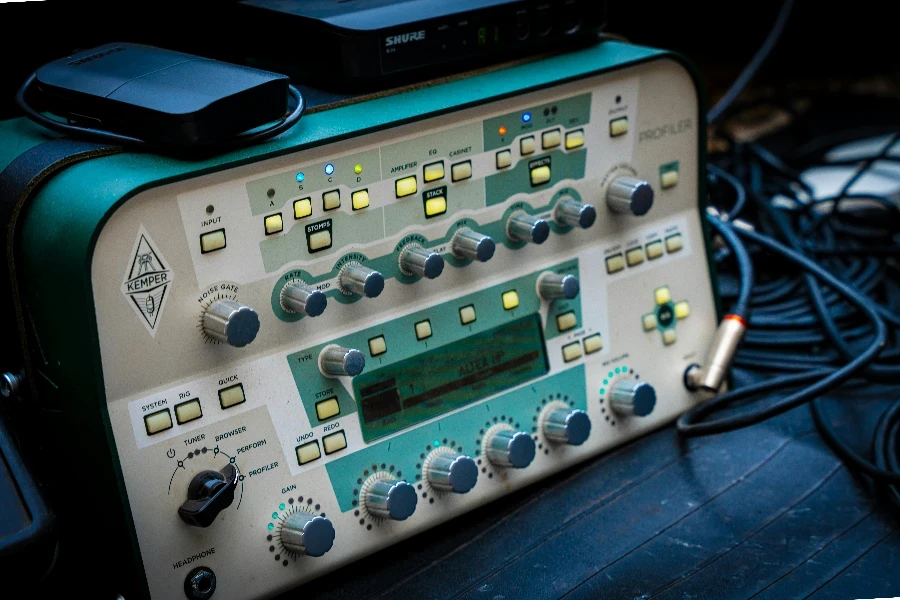The global market for audio amplifiers, particularly amp receivers, is projected to grow from USD 4.36 billion in 2024 to USD 5.63 billion by 2028, driven by the increasing demand for superior sound quality and smart home devices. This article explores the essential factors business buyers need to consider when selecting amp receivers for an enhanced audio experience.
Table of Contents:
– Amp Receivers For Audio Experience
– Key Factors When Selecting Amp Receivers for Audio Experience
– Performance and Functionality of Amp Receivers
– Design and Aesthetics of Amp Receivers
– Maintenance and Durability of Amp Receivers
Amp Receivers For Audio Experience

Market Overview: Amp Receivers in 2025
The global market for audio amplifiers, particularly amp receivers, is expected to grow from USD 4.36 billion in 2024 to USD 5.63 billion by 2028, at a compound annual growth rate (CAGR) of 6.6%. This growth is driven by the increasing demand for superior sound quality and the rising use of smart home devices. The adoption of consumer electronics, such as smartphones, laptops, and home audio systems, also contributes significantly to this trend.
The Asia-Pacific region led the market and is projected to remain the fastest-growing region through the forecast period. Countries like China, Japan, and India are driving this growth due to economic expansion, higher disposable incomes, and a tech-savvy young population. North America and Europe are also important markets, with high consumer spending on high-fidelity audio systems and smart home integrations.
Technological advancements, such as AI-driven amplifier technologies and modular designs, play a critical role in market dynamics. The integration of amp receivers into home theater systems and multi-room audio setups is becoming more common, enhancing the overall user experience and driving market growth.
Detailed Market Analysis and Insights
Amp receivers are essential for delivering high-quality audio experiences, transforming low-power audio signals into higher power outputs suitable for driving loudspeakers or headphones. This segment includes various types like Type D amplifiers, known for their high efficiency and compact size, popular in portable audio systems. The market also includes mono-channel, two-channel, four-channel, and six-channel configurations, catering to different audio needs.
Key performance benchmarks for amp receivers include signal-to-noise ratio (SNR), total harmonic distortion (THD), and power output. Leading companies like Texas Instruments Inc., STMicroelectronics N.V., and Infineon Technologies AG are developing amplifiers that excel in these parameters, ensuring clear and distortion-free sound reproduction.
Rising disposable incomes and increased consumer spending on home entertainment systems significantly impact market dynamics. The preference for high-fidelity audio output and the integration of amplifiers into smart home systems are notable trends. Seasonal demand patterns, with spikes during major sales events and holidays, reflect consumer behavior shifts towards enhanced audio experiences during festivities.
Distribution channel preferences are evolving, with a notable rise in online sales through eCommerce platforms. This shift is driven by the convenience and wider selection available online, supported by detailed product information and consumer reviews. However, traditional retail channels remain relevant, especially for high-end audio equipment where in-store demonstrations and expert advice are valued by consumers.
Recent Innovations and Future Prospects
Recent innovations in the amp receivers market include AI-driven sound processing, such as Shenzhen Goodix Technology Co., Ltd.’s TFA9865 smart amplifier. This technology automatically adjusts audio output for different content types, ensuring optimal sound quality across various scenarios. The integration of amplifiers into virtual reality systems and the emergence of modular designs that allow for upgrades and customization are also gaining traction.
The lifecycle of amp receivers typically involves stages from product development and introduction to growth, maturity, and eventual decline. However, continuous innovation and technological advancements can extend the lifecycle, maintaining consumer interest and driving sustained demand. Digitalization and the integration of IoT technologies are reshaping the market, enabling more sophisticated and personalized audio experiences.
Environmental regulations are increasingly influencing the market, with a growing emphasis on energy efficiency and sustainability. Companies are focusing on developing amplifiers that consume less power and use eco-friendly materials, aligning with global environmental standards and consumer preferences for green products.
Customer pain points often revolve around the complexity of setting up and integrating various audio components. Leading brands are addressing these issues through user-friendly designs, comprehensive installation guides, and robust customer support. Brand positioning strategies emphasize superior sound quality, innovative features, and seamless integration with smart home systems, differentiating their products in a competitive market.
Niche markets, such as professional audio setups and automotive audio systems, present significant growth opportunities. The demand for high-performance audio solutions in professional settings and the rising trend of premium audio systems in vehicles underscore the diverse applications and potential of amp receivers.
The amp receivers market is poised for robust growth, driven by technological advancements, increasing consumer demand for high-quality audio experiences, and the integration of smart home technologies. With continuous innovations and a focus on sustainability, the market offers significant opportunities for businesses to thrive and cater to evolving consumer preferences. As the market evolves, staying abreast of trends and leveraging strategic insights will be crucial for success in this dynamic industry.
Key Factors When Selecting Amp Receivers for Audio Experience

When selecting the optimal amp receiver to enhance your audio experience, several critical factors come into play. Each element significantly impacts the performance, usability, and longevity of the equipment. Below, we explore the most crucial aspects to help you make an informed decision.
Audio Quality
Audio quality is paramount when choosing an amp receiver. The device should deliver clear, crisp, and well-balanced sound across all frequencies.
Total Harmonic Distortion (THD): Look for receivers with a THD of less than 0.1% to ensure minimal distortion.
Signal-to-Noise Ratio (SNR): A higher SNR, preferably above 90 dB, indicates less background noise and clearer audio output.
Frequency Response: Opt for a receiver with a broad frequency range, typically from 20 Hz to 20 kHz, to accurately reproduce the full spectrum of sound.
Power Output
The power output of an amp receiver is crucial, especially in larger rooms or with high-demand speakers.
Watts per Channel (WPC): Ensure the receiver provides adequate power per channel, generally between 50 to 200 watts for home use.
Impedance Compatibility: Match the receiver’s impedance capabilities with your speakers, commonly 4, 6, or 8 ohms, to optimize performance and prevent damage.
Connectivity Options
A modern amp receiver should offer various connectivity options to accommodate different devices and future upgrades.
HDMI Inputs/Outputs: Multiple HDMI ports are essential for connecting TVs, gaming consoles, and Blu-ray players.
Wireless Connectivity: Features like Bluetooth, Wi-Fi, and AirPlay allow for seamless streaming from smartphones, tablets, and computers.
Analog and Digital Inputs: Ensure the receiver has both analog (RCA) and digital (optical/coaxial) inputs to connect older and newer audio sources.
Latest Technology Features
Incorporating the latest technology can significantly enhance your audio experience and future-proof your investment.
Dolby Atmos and DTS:X: These immersive audio formats provide a 3D sound experience, essential for modern home theaters.
4K and 8K Pass-Through: Ensure the receiver supports the latest video resolutions to maintain compatibility with high-definition content.
Voice Control: Integration with voice assistants like Amazon Alexa or Google Assistant adds convenience and ease of use.
Build Quality and Design
The build quality and design of the amp receiver affect its durability, aesthetic appeal, and functionality.
Chassis Construction: Look for receivers with robust construction, such as aluminum or steel, to reduce vibrations and enhance longevity.
Ventilation: Proper ventilation is crucial to prevent overheating, especially during prolonged use.
User Interface: A well-designed, intuitive user interface, preferably with a graphical display, makes setup and operation easier.
Performance and Functionality of Amp Receivers

When evaluating the performance and functionality of amp receivers, several key aspects ensure the receiver meets and exceeds your audio expectations.
Amplification and Channel Support
The amplification capability and the number of supported channels are critical for delivering a powerful and immersive audio experience.
Class of Amplification: Class A, AB, and D amplifiers offer different efficiencies and sound qualities. Class AB is often preferred for its balance between sound quality and efficiency.
Channel Configuration: Common configurations include 5.1, 7.1, and 9.2 channels. More channels provide better surround sound and are ideal for larger setups.
Calibration and Equalization
Advanced calibration and equalization features ensure your amp receiver delivers optimal sound tailored to your specific environment.
Automatic Room Calibration: Technologies like Audyssey MultEQ or YPAO analyze and adjust the audio output based on room acoustics.
Manual Equalization: Allows for fine-tuning frequencies to suit personal preferences or specific audio characteristics.
Multi-Room Audio
Multi-room audio capabilities enable you to distribute audio throughout your home, providing a cohesive and versatile listening experience.
Zone Support: Some receivers support multiple zones, allowing different audio sources to play in various rooms simultaneously.
Wireless Multi-Room Systems: Integration with systems like Sonos or HEOS allows for easy expansion and control of your audio setup across different areas.
Design and Aesthetics of Amp Receivers

The design and aesthetics of amp receivers are essential for functionality and blending seamlessly into your home environment.
Size and Form Factor
The physical dimensions of the receiver should match your available space and fit well with other home theater components.
Standard Dimensions: Most receivers fit within standard AV racks, but always check measurements to ensure compatibility.
Form Factor: Slimline models are available for those with limited space, though they may offer fewer features.
Control and Display
User interaction with the receiver is facilitated through its controls and display features.
Front Panel Display: A clear, readable display with essential information like volume level, input source, and audio format is crucial.
Remote Control and App Integration: A well-designed remote and the option to control the receiver via a smartphone app add convenience.
Aesthetic Integration
The receiver should complement your home decor and other AV equipment for a cohesive look.
Color and Finish: Common finishes include black, silver, and brushed aluminum, which match most AV setups.
LED Lighting: Adjustable LED lighting can enhance the receiver’s appearance and match your room’s ambiance.
Maintenance and Durability of Amp Receivers

Ensuring the longevity and consistent performance of your amp receiver involves proper maintenance and understanding its durability features.
Build Quality and Materials
High-quality materials and construction techniques contribute to the durability and reliability of the receiver.
Internal Components: Premium components like capacitors and resistors ensure stable performance and longevity.
External Housing: Durable materials like metal casings protect internal components from damage and interference.
Maintenance Requirements
Regular maintenance can prolong the life of your receiver and maintain its performance.
Dust and Ventilation: Keep the receiver dust-free and ensure adequate ventilation to prevent overheating.
Firmware Updates: Regularly update the firmware to benefit from the latest features and performance improvements.
Warranty and After-Sales Service
A comprehensive warranty and reliable after-sales service are crucial for peace of mind and long-term satisfaction.
Warranty Coverage: Look for receivers with at least a two-year warranty covering parts and labor.
Customer Support: Reputable brands offer robust customer support, including troubleshooting, repairs, and replacements.
Conclusion
In summary, selecting the right amp receiver involves considering various factors, including audio quality, power output, connectivity options, latest technology features, and build quality. By evaluating these elements, you can ensure that your chosen receiver meets your audio needs and enhances your overall listening experience.




